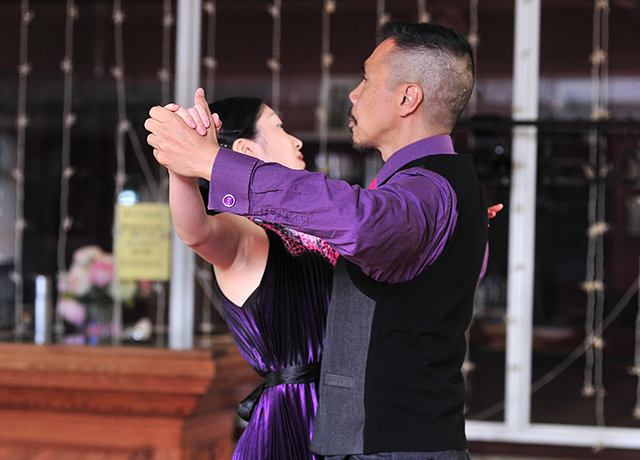CBM, and Why it Helps Your Partnered Turns

Happy New Year y’all! ’Tis the season when new resolutions are made, including resolutions to drag your partner into a dance studio for the first time and pray he/she doesn’t run out screaming at the end of it. It’s ALSO a time for more experienced dancers to set new benchmarks to work towards. This month is for you guys.
Reverse turns – and their counterpart, the natural, or right turns – form the backbone of Viennese waltz, and at least the ribs for slow waltz, tango, and silver foxtrot. It’s a partnered turn (i.e. you don’t release your frame), and while there are little differences in shaping and amount of turn, the essential technique remains the same.
One of the toughest parts about these turns is the concept of CBM, or “contra body movement”. CBM means literally means rotating your upper body in a direction contrary to the lower body, creating a twisting sensation in your belly. For example, if you step forward with the left foot while rotating your body to the left, that’s CBM.
Let’s use an example: Imagine your body is a ship on the ocean. Your lower half indicates where the ship is currently headed – we usually look at the direction our toes are pointing to confirm this. The upper half is the steering wheel for the ship.
As anyone who’s watched Titanic knows, ships don’t turn the instant the steering wheel is rotated – they take time to respond. Likewise, when we rotate our body into the left or right turn (CBM), our toes should only start changing direction on the step after.
Here’s what people usually do on the forward half of a reverse turn (for a natural/right turn, substitute R for L):
- LF forward, making 1/8 turn L (with the L toe, 1/4 turn L for Viennese waltz)
- Make 1/8 turn L, RF side and slightly back
- LF closes to RF, making another 1/8 turn L
And here’s the better option, using CBM:
- LF forward (1/8 turn L for Viennese waltz), body rotates L into CBM
- Begin 3/8 turn L, RF forward and rotating to the side as body changes weight
- Completing majority of turn, LF closes to RF (making another 1/8 turn L if this is Viennese waltz)
We cover a lot move distance by stepping forward than stepping sideways, because we can roll through the full length of the foot. Since partnered turns are all about covering ground while passing each other, the second example will feel MUCH better, because it uses two forward steps, while the first example barely uses one.
The only downside for the second option is contact position is practically required: your partner needs to be dancing closely enough to match your foot positions without cutting you off. But that’s another story, for another day.
About the Author
Ian Crewe has been dancing ballroom for over 18 years, and has a Licentiate in American smooth and rhythm. His passion for dance eventually led him to blogging and the World Wide Web. Ian currently teaches at the Joy of Dance Centre, Toronto, ON, Canada.

